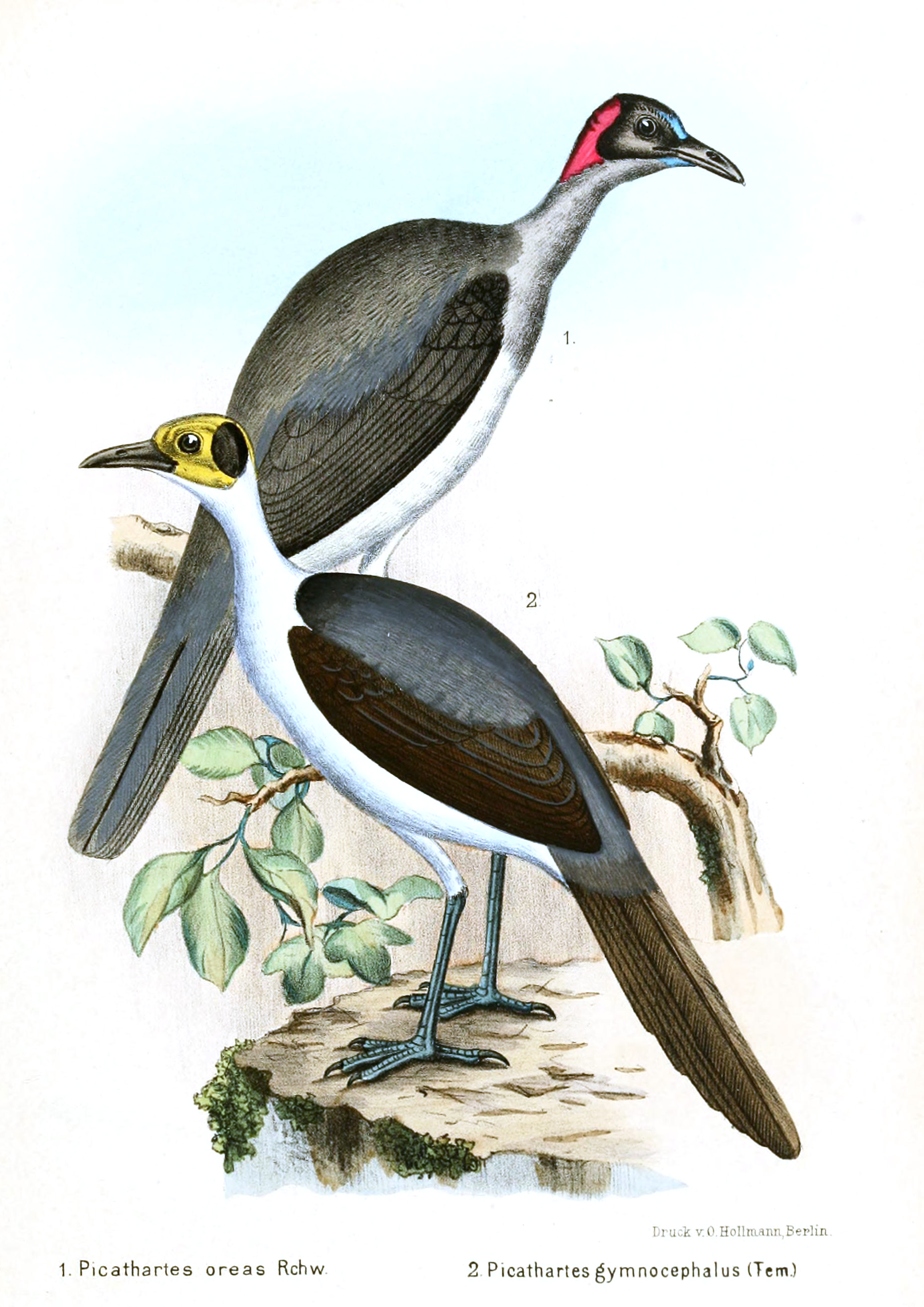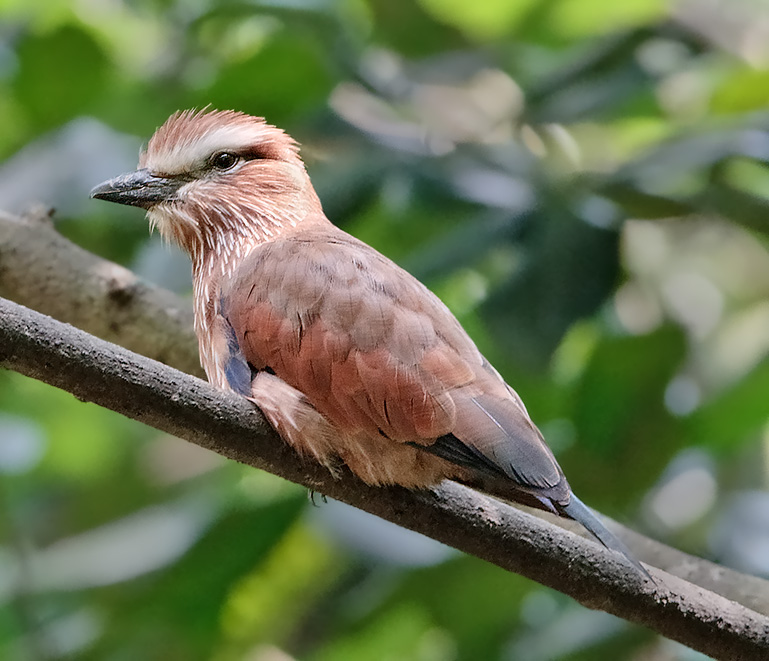|
Rockfowl
The picathartes, rockfowl, or bald crows are a small genus of two passerine bird species forming the family Picathartidae found in the rain-forests of tropical west and central Africa. They have unfeathered heads, and feed on insects and invertebrates picked from damp rocky areas. Both species are totally non-migratory, being dependent on a specialised rocky jungle habitat. Both species are listed as vulnerable to extinction on the IUCN Red List. Taxonomy and systematics The taxonomic position of the clade and its two species has been confusing. At various times, it has been grouped with the babblers, flycatchers, starlings, crows and others before being placed in a family of its own. Serle in 1952 thought it resembled the Asian genus ''Eupetes'' while Sibley used egg-albumin protein similarity, determined by electrophoresis, to suggest that it belonged to the Timaliidae. Olson revived the idea that it was related to ''Eupetes'' in 1979. A molecular sequence based study sugg ... [...More Info...] [...Related Items...] OR: [Wikipedia] [Google] [Baidu] |
White-necked Rockfowl
The white-necked rockfowl (''Picathartes gymnocephalus'') is a medium-sized bird in the family Picathartidae, with a long neck and tail. Also known as the white-necked picathartes, this passerine is mainly found in rocky forested areas at higher altitudes in West Africa from Guinea to Ghana. Its distribution is patchy, with populations often being isolated from each other. The rockfowl typically chooses to live near streams and inselbergs. It has no recognized subspecies, though some believe that it forms a superspecies with the grey-necked rockfowl. The white-necked rockfowl has greyish-black upperparts and white underparts. Its unusually long, dark brown tail is used for balance, and its thighs are muscular. The head is nearly featherless, with the exposed skin being bright yellow except for two large, circular black patches located just behind the eyes. Though the bird is usually silent, some calls are known. These rockfowl feed primarily on insects, though parents feed smal ... [...More Info...] [...Related Items...] OR: [Wikipedia] [Google] [Baidu] |
Grey-necked Rockfowl
The grey-necked rockfowl (''Picathartes oreas'') is a medium-sized bird in the family Picathartidae with a long neck and tail. Also known as the grey-necked picathartes, this passerine is mainly found in rocky areas of close-canopied rainforest from south-west Nigeria through Cameroon, Equatorial Guinea, and south-west Gabon. It additionally lives on the island of Bioko. Its distribution is patchy, with populations often isolated from each other. The rockfowl typically chooses to live near streams and inselbergs in its forested habitat. It has no recognized subspecies, though some believe that it forms a superspecies with the white-necked rockfowl. The grey-necked rockfowl has grey upperparts, a light grey breast, and lemon-coloured underparts. Its unusually long tail is used for balance, and its thighs are muscular. The head is nearly featherless, with the exposed skin being powder blue on the forehead and upper mandible and carmine on the hindcrown. The bird's cheeks and eyes a ... [...More Info...] [...Related Items...] OR: [Wikipedia] [Google] [Baidu] |
Picathartes Oreas
The grey-necked rockfowl (''Picathartes oreas'') is a medium-sized bird in the family Picathartidae with a long neck and tail. Also known as the grey-necked picathartes, this passerine is mainly found in rocky areas of close-canopied rainforest from south-west Nigeria through Cameroon, Equatorial Guinea, and south-west Gabon. It additionally lives on the island of Bioko. Its distribution is patchy, with populations often isolated from each other. The rockfowl typically chooses to live near streams and inselbergs in its forested habitat. It has no recognized subspecies, though some believe that it forms a superspecies with the white-necked rockfowl. The grey-necked rockfowl has grey upperparts, a light grey breast, and lemon-coloured underparts. Its unusually long tail is used for balance, and its thighs are muscular. The head is nearly featherless, with the exposed skin being powder blue on the forehead and upper mandible and carmine on the hindcrown. The bird's cheeks and eyes a ... [...More Info...] [...Related Items...] OR: [Wikipedia] [Google] [Baidu] |
Rockjumper
The rockjumpers are medium-sized insectivorous or omnivorous birds in the genus ''Chaetops'', which constitutes the entire family Chaetopidae. The two species, the Cape rockjumper, ''Chaetops frenatus'', and the Drakensberg rockjumper, ''Chaetops aurantius'', are endemic residents of southern Africa.del Hoyo, J.; Elliot, A. & Christie D. (editors). (2007). '' Handbook of the Birds of the World. Volume 12: Picathartes to Tits and Chickadees.'' Lynx Edicions. The Cape rockjumper is a resident of the West Cape and south-west East Cape, and the orange-breasted (or Drakensberg) rockjumper is distributed in the Lesotho Highlands and areas surrounding them in South Africa. The two rockjumpers have been treated as separate species but differ in size and plumage. The ranges do not overlap, but come close to doing so. Taxonomy and systematics Originally, these birds were placed in the thrushes, and they have also been placed with the Old World warblers and the babblers, but recent DNA ... [...More Info...] [...Related Items...] OR: [Wikipedia] [Google] [Baidu] |
Passerida
Passerida is, under the Sibley-Ahlquist taxonomy, one of two parvorders contained within the suborder Passeri (standard taxonomic practice would place them at the rank of infraorder). While more recent research suggests that its sister parvorder, Corvida, is not a monophyletic grouping, the Passerida as a distinct clade are widely accepted. Systematics and phylogeny The Passerida quite certainly consist of the 3 ''major'' subclades outlined by Sibley & Ahlquist (1990). However, their content has been much revised. In addition, it has turned out that not all passeridan lineages neatly fit into this arrangement. The kinglets are so distinct that they might actually form a separate infraorder, as they are only slightly less basal than the Corvoidea or the Picathartidae. See Jønsson & Fjeldså (2006) for details on phylogeny. Superfamily Sylvioidea Mostly smallish insectivores, distribution centered on the Indo-Pacific region. Few occur in the Americas, highest diversity of famili ... [...More Info...] [...Related Items...] OR: [Wikipedia] [Google] [Baidu] |
Coracias
''Coracias'' is a genus of the rollers, an Old World family of near passerine birds related to the kingfishers and bee-eaters. They share the colourful appearance of those groups, blues and browns predominating. The two outer front toes are connected, but not the inner one. Taxonomy The genus ''Coracias'' was introduced in 1758 by the Swedish naturalist Carl Linnaeus in the tenth edition of his '' Systema Naturae''. The genus name is from Ancient Greek ''korakías'' (), derived from ''korax'' (, ‘raven, crow’). Aristotle described the ''coracias'' as a bird as big as a crow with a red beak, which some believe to be the chough. The type species was designated as the European roller (''Coracias garrulus'') by George Robert Gray in 1855. The phylogenetic relationships among the species were determined in a molecular study published in 2018. Species Nine species are recognized: Former species Formerly, some authorities also considered the following species (or subspeci ... [...More Info...] [...Related Items...] OR: [Wikipedia] [Google] [Baidu] |
Passerine
A passerine () is any bird of the order Passeriformes (; from Latin 'sparrow' and '-shaped'), which includes more than half of all bird species. Sometimes known as perching birds, passerines are distinguished from other orders of birds by the arrangement of their toes (three pointing forward and one back), which facilitates perching. With more than 140 families and some 6,500 identified species, Passeriformes is the largest clade of birds and among the most diverse clades of terrestrial vertebrates, representing 60% of birds.Ericson, P.G.P. et al. (2003Evolution, biogeography, and patterns of diversification in passerine birds ''J. Avian Biol'', 34:3–15.Selvatti, A.P. et al. (2015"A Paleogene origin for crown passerines and the diversification of the Oscines in the New World" ''Molecular Phylogenetics and Evolution'', 88:1–15. Passerines are divided into three clades: Acanthisitti (New Zealand wrens), Tyranni (suboscines), and Passeri (oscines or songbirds). The passeri ... [...More Info...] [...Related Items...] OR: [Wikipedia] [Google] [Baidu] |
Corvida
The "Corvida" were one of two "parvorders" contained within the suborder Passeri, as proposed in the Sibley-Ahlquist taxonomy, the other being Passerida. Standard taxonomic practice would place them at the rank of infraorder. More recent research suggests that this is not a distinct clade—a group of closest relatives and nothing else—but an evolutionary grade instead. As such, it is abandoned in modern treatments, being replaced by a number of superfamilies that are considered rather basal among the Passeri. It was presumed that cooperative breeding—present in many or most members of the Maluridae, Meliphagidae, Artamidae and Corvidae, among others—is a common apomorphy of this group.Cockburn (1996) But as evidenced by the updated phylogeny, this trait is rather the result of parallel evolution, perhaps because the early Passeri had to compete against many ecologically similar birds (see near passerine). Placement of "Corvida" families This table lists, in taxonomic ... [...More Info...] [...Related Items...] OR: [Wikipedia] [Google] [Baidu] |
Eupetes
The rail-babbler or Malaysian rail-babbler (''Eupetes macrocerus'') is a strange, rail-like, brown and pied ground-living bird. It is the only species in the genus ''Eupetes'' and family Eupetidae. It lives on the floor of primary forests in the Malay Peninsula and Sumatra (the nominate subspecies ''macrocerus''), as well as Borneo (ssp. ''borneensis''). It is distantly related to African crow-like birds. Its population has greatly decreased because much of the lowland primary forest has been cut, and secondary forests usually have too dense a bottom vegetation or do not offer enough shade to be favourable for the species. However, it is locally still common in logged forest or on hill-forest on slopes, and probably not in immediate danger of extinction. The species is poorly known and rarely seen, in no small part due to its shyness. Taxonomy Opinions on the correct taxonomic placement for the rail-babbler have differed. At one time, it was placed in the Old World babbler ... [...More Info...] [...Related Items...] OR: [Wikipedia] [Google] [Baidu] |
Storrs L
{{disambiguation, geo ...
Storrs may refer to: * Storrs (surname) * Storrs, Connecticut, a village where the main campus of the University of Connecticut is located * Storrs, South Yorkshire, a rural hamlet within the City of Sheffield, England * Storrs, Cumbria See also * Storrs Hall, a listed building in Cumbria, England * Yealand Storrs, a hamlet in the English county of Lancashire * Storr Storr is a surname of Old Scandinavian origin, and may refer to * Anthony Storr (1920–2001), English psychiatrist and author * Catherine Storr (1913–2001), English novelist and children's writer * Farrah Storr (born 1978), British journalist * ... [...More Info...] [...Related Items...] OR: [Wikipedia] [Google] [Baidu] |
Lake Edward
Lake Edward (locally Rwitanzigye or Rweru) is one of the smaller African Great Lakes. It is located in the Albertine Rift, the western branch of the East African Rift, on the border between the Democratic Republic of the Congo (DRC) and Uganda, with its northern shore a few kilometres south of the equator. History Henry Morton Stanley first saw the lake in 1888, during the Emin Pasha Relief Expedition. The lake was named in honour of Albert Edward, Prince of Wales, son of then British monarch Queen Victoria, and later to become King Edward VII. In 1973, Uganda and Zaire (DRC) renamed it Lake Idi Amin after Ugandan dictator Idi Amin. After his overthrow in 1979, it recovered its former name. In 2014, the lake was the center of an oil dispute. SOCO international entered the premises of the Virunga National Park where the lake is situated to prospect for oil. However, villagers and workers who attempted to stop the oil company from entering the area were beaten up and even kidnapp ... [...More Info...] [...Related Items...] OR: [Wikipedia] [Google] [Baidu] |





